#Agriculture Image Labeling
Explore tagged Tumblr posts
Text
Empowering Agriculture with Precision: Image Labeling, Dataset Creation, and AI Training Data
Discover how HAIVO AI, your trusted AI training data company, is enhancing agriculture image labeling and dataset creation. We provide the foundation for your AI projects, ensuring accuracy and excellence.

0 notes
Text
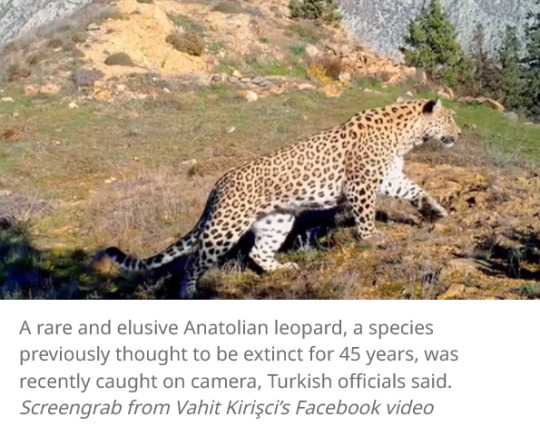

Trail cameras in the mountains of Turkey captured a rare sighting of a leopard species previously considered extinct for decades, officials said. The Anatolian leopard was filmed prowling around the mountains in two separate regions, Turkey’s Ministry of Agriculture and Forestry said in a Thursday, Jan. 26, news release. Vahit Kirişci, a ministry official, shared footage of the wildcat on Facebook. [...] Anatolian leopards are an endangered species, Turkish officials said. The last leopard was thought to be killed in 1974, and the species was considered extinct for 45 years. However, a male Anatolian leopard was spotted in 2019. Researchers have traced the rare leopard species to four regions in Turkey, but little is known about the animal’s population size and distribution, according to the release. [...] Turkish officials did not specify where the leopard was seen or when the different videos were taken. Experts estimate only 10 to 15 Anatolian leopards still live in the wild, according to Biology Online. [...]
---
All content above, headline, image, caption, and text published by: Aspen Pflughoeft. “Elusive and rare leopard - considered extinct for 45 years - caught on film in Turkey.” Miami Herald. 26 January 2023.
---
For context, the historic and current distribution range of the leopard:
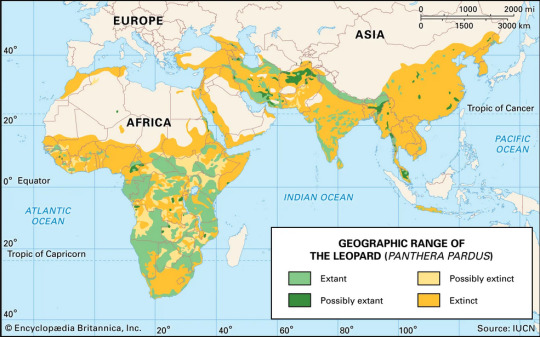
Leopards are now extinct across most of their former habitat throughout Asia. Most of this extinction happened only since 1900 AD.
The “Anatolian leopard” of the Anatolian peninsula and eastern Mediterranean is sometimes considered to be a variation of and synonymous with the so-called “Persian leopard” which lives nearby in the Caucasus and Persia. Together, the Anatolian and Persian leopards are referred to either as Panthera pardus saxicolor or Panthera pardus tulliana.
Here is the current known distribution range of the recognized subspecies of leopard. On this map, the Anatolian and Persian leopards are labeled as “P.p. saxicolor” range and shown in orange color:

More recent images of the Anatolian leopard within Turkey. These screenshots are from the social media page of Vahit Kirişci, January 2023:
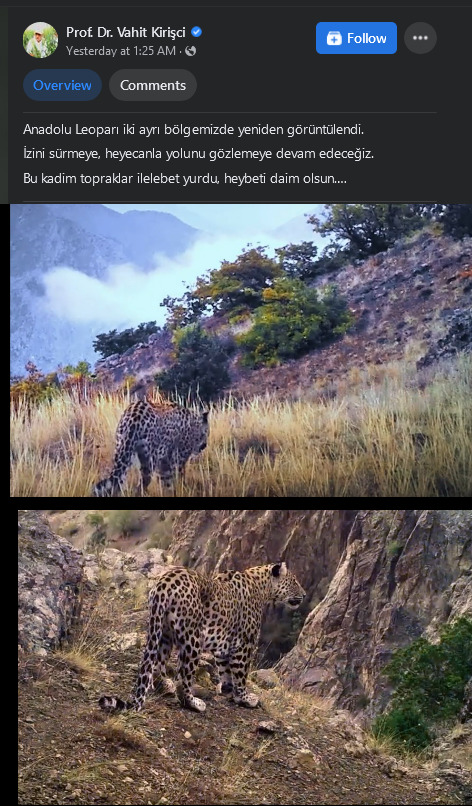
430 notes
·
View notes
Text
罠英語・Trap Words pt 1
和製英語(わせいえいご)are Japanese words that have some origin in English, but have been appropriated by the Japanese speaking community. Often, if converted from katakana to English, they won’t be real English words (which can sometimes lead to funny mistranslations on signs).
シャーペン → shar-pen?? ❌ → mechanical pencil ✅
トランプ → trump?? ❌ → playing cards ✅
ベビーカー → baby car?? ❌ → stroller/pram ✅
However, there is a subcategory of 和製英語 which is particularly insidious, as a japanese learner. I’m gonna call them 罠英語 - trap words. They appear to be a normal English word simply converted into kanakana, but although they look like a regular old loan word, they are actually a Japanese misinterpretation or reinterpretation of an English word.
マンション → mansion ❌ → condominium/apartment ✅
The most well known example is probably マンション. Each of these words has a history which explains how they became trap words. In マンション’s case, it was business. In the 1960s, Japanese developers were building luxury housing complexes, but wanted to differentiate them from other housing complexes that had a low-class image, like public housing.¹ As far as I can tell, it wasn’t just one company, and マンション wasn’t a brand name. They created a whole new word, borrowing from English. Since then, the word マンション evolved to have a wider and wider scope, now including not just luxury housing complexes but any housing complex.
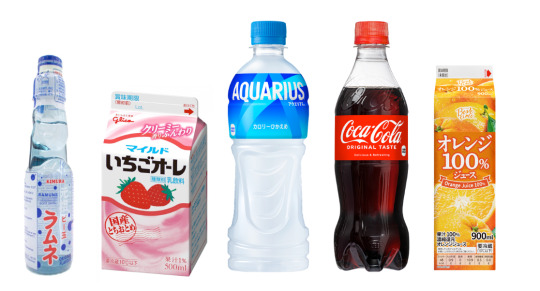
ジュース → juice ❌ → juice/soft drink/sports drink/mixer ✅
This one drives me up the wall because of how different it is from English. ジュース is a huge umbrella term which includes Coke, Aquarius, ramune, flavoured milk(!!), and actual orange juice. It does NOT include coffee, tea, anything with alcohol, or lemon juice(!!). Why not lemon juice? Because ジュース kinda means “beverage”. You don't usually drink lemon juice straight, so it’s not ジュース. Instead, you call lemon juice レモン汁. There are plenty of recipes on the japanese recipe sharing website Cookpad for レモンジュース, and most of them involve diluting actual lemon juice in carbonated water and mixing it with sugar or honey.²
Apparently, up until the 1960s (〜昭和40年), the word ジュース was not regulated, which meant Japanese brands were free to label fruit flavoured drinks as ジュース, even if they had no actual fruit juice in them. This changed in late 1967, when, thanks to pressure from consumer groups, the Japanese Agricultural Standard Law (JAS法) was revised to include a regulatory definition of the word ジュース: 「果汁100%のもの以外は、『ジュース���という名称で���売できない」(100% fruit juice).³ Even the wikipedia article for ジュース defines it using the JAS definition.⁴ However, the word ジュース had already entered common usage before the law came into effect, and it’s still used today to mean any non-coffee, non-tea, non-alcoholic, sweet beverage, especially ones sold from a vending machine. I believe the prevalence of vending machines may have led to the spread of this word. Another reason ジュース has not been adopted in common use may be that Japanese already has a word for fruit juice - 果汁. Languages dislike redundancy, so it’s natural that one of the two would have changed to have a different meaning. Many native Japanese speakers are unaware of the regulatory definition⁵, (and even then, regulations shouldn’t and don’t dictate how language is used in everyday conversation) so it’s important to be careful!
ノート → note ❌ → notebook ✅
In Japanese, it’s rare that a common word will be longer than 4 kana sounds long (aka morae). Similarly in English, we don’t end to use words that are over 4 syllables long very often. In English, the word “notebook” is 2 syllables, nice and short. But when you convert it into Japanese, it becomes ノートブック, a whole 6 morae! No one has time to say all that! Since English can fit multiple consonants into a single syllable but Japanese can’t, when converting to Japanese, lots of additional vowels get added in, which extends the word. That’s why loan words in Japanese tend to get abbreviated: ビル for building, リモコン for remote control, ティアキン for “Tears of the Kingdom”.⁶ It’s only natural that ノートブック would get abbreviated to ノート. It’s just an unlucky coincidence that “note” happens to be an English word as well. The word for "note" in Japanese is メモ!
This is why the Death Note is called a note, even though it’s not a note, and also gives us this slightly おかしい translation.

I’m keen to post more about these trap words since dictionaries are often quite prescriptivist about the meanings, and it’s hard to get a good idea of what the word means without talking to Japanese people. I also find the histories quite interesting. Let me know if you’re interested! I have a feeling these words (besides ジュース) may be kinda common knowledge, but I hope the explanations were interesting! I think next time I'll talk about some ones that are less commonly known.
[1]: https://www.homes.co.jp/cont/buy_mansion/buy_mansion_00137/ [2]: https://cookpad.com/search/レモンジュース [3]: https://www.meg-snow.com/customer/center/communication/pdf/center12.pdf [4]: https://ja.wikipedia.org/wiki/ジュース [5]: https://macaro-ni.jp/36654 [6]: https://en.wikipedia.org/wiki/Japanese_abbreviated_and_contracted_words
#langblr#japanese#language acquisition#language learning#linguistics#japanese language#learning japanese#language#jimmy blogthong#trap words#official blog post
156 notes
·
View notes
Text

Rosalind Franklin, chemist and DNA crystallographer.
Rosalind Franklin (1920-1958) has been called “the unsung hero of the double helix” after she failed to win recognition for her work in discovering the double-helix DNA.
Rosalind was born in London to a wealthy Jewish family. She studied chemistry at Cambridge University. She then went on to study the structures of carbon in coal, and later, viruses in plants and animals. In the 1940s, she studied plant viruses that blighted important agricultural crops, including the potato, turnip, tomato and pea. In 1957, she conducted research into the virus that causes polio.
In 1953, she made the most important discovery in her career. Using x-ray equipment and a micro-camera, Franklin photographed and analyzed samples of DNA. In May 1952, Franklin and a graduate student took a ground-breaking photo, labelled #51, which unequivocally provided the first clear image of DNA and its helical pattern.
Franklin’s research results had been passed to fellow scientists James Crick and Francis Watson without her knowledge or permission. Her photo, and her precise analysis of the x-ray diffraction data inspired Crick and Watson to reject their initial idea of a three-helix molecule and make the necessary calculations to develop the double helix model of the DNA strand we now know. Without Franklin, there likely would have been no global recognition for Watson and Crick and no Nobel Prize.
Crick and Watson were awarded the Nobel Prize in 1962. Franklin had already died of ovarian cancer in 1957 at the tragically young age of 37. When Crick and Watson were given their prize they not only did not acknowledge Franklin’s contribution to their work, they never even mentioned her name in any of their publications.
Franklin may not have been recognized during her lifetime, but years later, Watson and Crick did eventually acknowledge her contributions. In a book published in 1968, “The Double Helix” Watson wrote, “The instant I saw the picture my mouth fell open and my pulse began to race. The black cross of reflections which dominated the picture could only arise from a helical structure.”
There is now a Rosalind Franklin University of Medicine and Science in Chicago, which was originally founded in 1912 as the Chicago Hospital-College of Medicine, and was renamed after Franklin in 2004. Franklin has also become greater known among the general public, and was placed fifth in the 2018 BBC History Magazine poll of the world’s most influential women.
Finally, years after her death, Rosalind Franklin, whose work was instrumental in unlocking the structure of DNA, is receiving the recognition she deserved for so long.
Historical Photos of Women's Stories
122 notes
·
View notes
Text
i found this awesome artist Libor Balák who paints a lot of prehistoric reconstructions for museums etc. i did already know some of his paitnings but wasn't aware what his name is... he deserves to be recognised for his works... so here are his reconstructions of the Lengyel culture taken from his website (one of my favourite cultures btw)
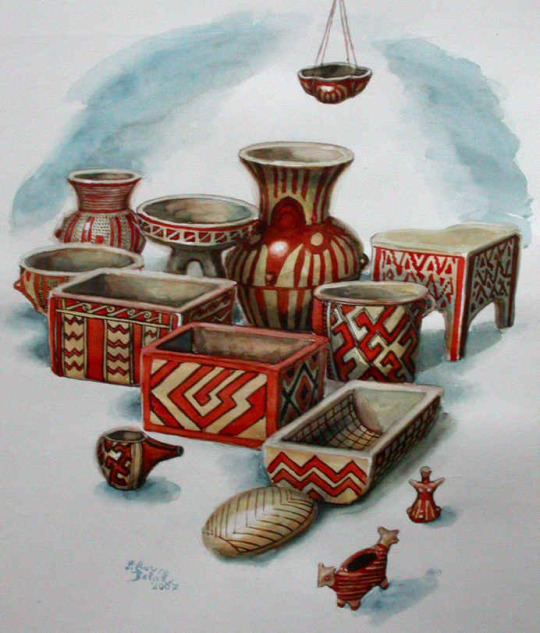
This Neolithic culture has left a distinctive archaeological signature centred in southern Moravia, but also included southwest Slovakia and adjacent parts of Austria and Hungary. Temporally belongs to late Neolithic – about 5000 B.C.
Colourfully decorated ceramics constituted a distinct element of this culture, which subsequently spread into northern Poland, Bohemia and central Germany. Apart from pots, ceramic spoons, ladles, cubic lamplets and models of various objects and structures are known from southern Moravia. This society also possessed advanced agriculture.

Model of a small dwelling is transformed into reality
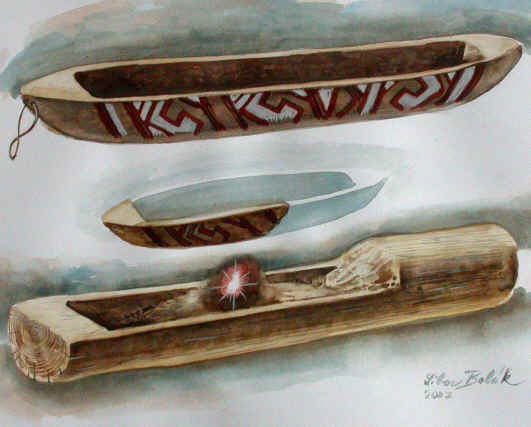
Ceramic fragment labelled as a ship is transformed into watercraft decoration – a monoxylon manufactured from a single piece of tree trunk
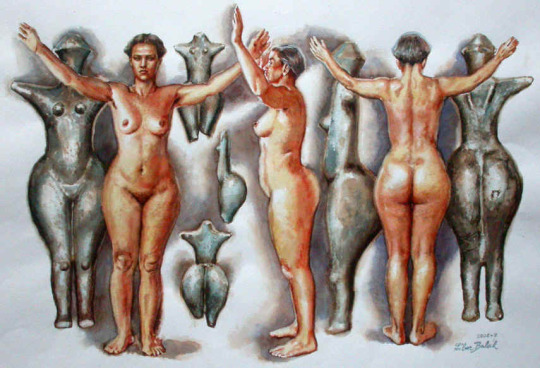
The meaning of the nakedness of the figurines is also controversial; some of the figurines could have had clothes painted on them..
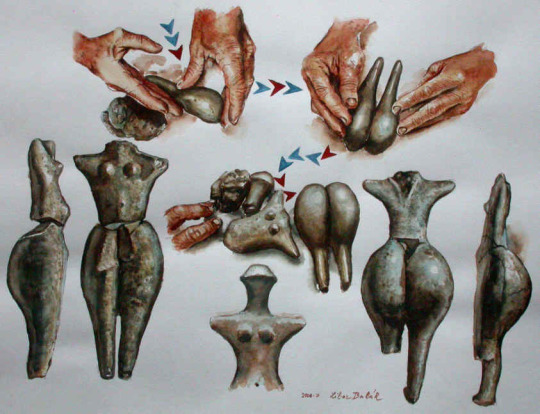
The painting displays the technological stages of Venus figurine manufacture
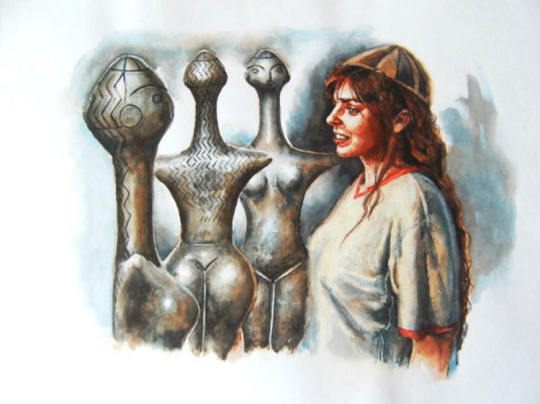
The Middle European Lengyel statuettes are first of all of a high handcrafted quality and very decorative. The shapes and patterns are taken over from the earlier statuettes. Some of them bear specific anatomical and ethnographic elements, such as the Venuse with schematic curly hair.

This statuette has schematic straight hair.
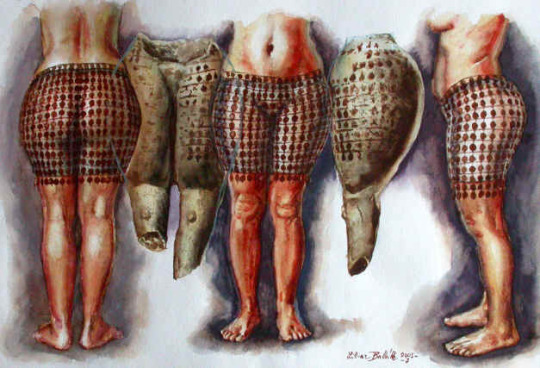
One of the many pieces of the Venus figurines from Neolithic era, found in South Moravia. This fraction has a preserved coloration with geometrical patterns.The figurine is uncomplete, it could also have had complet clothing.

The figurine of a woman in a skirt is decorated with ceramic lugs. The statuette could also be wearing a complete dress, not only a skirt on a bare body
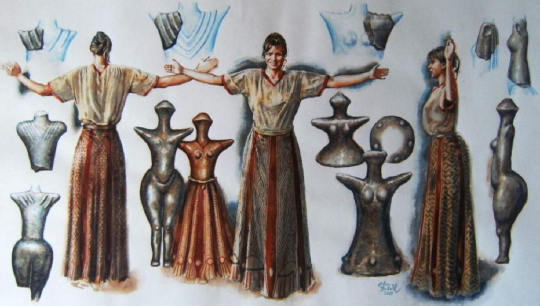
The reconstructive transformation on this picture analyzes the skew elements in the place of the shoulder blades – it could be draped textiles
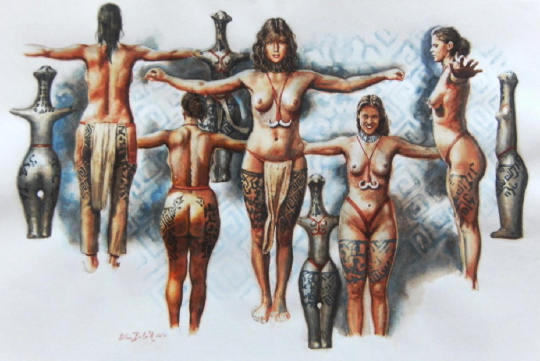
On this statuette found in Austria we can see the preserved traces of the original painting. The interesting fact is also the hole between it´s tights. It could serve for interlacing of the waistcloth or, less probably, for fixing of the figure to the base; the fingertips would hinder the perfect fixing. The image represents the possibilities of the painting interpretation – the decorative leggings on the tights, tattooes, paintings on the skin and a necklace in the form of boar tusks. We can also see the decoration on the neck.
#lengyel culture#neolithic#archaeology#prehistory#stone age#figurines#female figurines#pottery#artefact#reconstruction#anthropomorphic figurine#my upl#Libor Balák#art#czech art
14 notes
·
View notes
Text

Ancient Egyptian god Osiris seen here doing the “Land o’ Lakes” Yes, I used a symmetry tool.
Land o lakes is a farmer-owned dairy co-op in the US. They used to have a woman on their label. The woman wore a kitschy-idyllic “native” costume and was removed out of respect to North American First Nations. It always made me consider the idyllic way agriculture is often depicted. Not that land o lakes is a big offender but that image was so powerful - and almost comical.
I try to depict Ancient Egypt in unconventional ways. Seeking to finally perceive as human, a people often depicted as otherworldly and strange.
7 notes
·
View notes
Note
What plants are native to Ganymede
It's mostly just the ones that are used in agriculture, i.e. crops, but it also has a bunch of other plants:

(If you click each of the plants labeled with a different language on the Wikipedia page you can see images of the plants and learn the names of some of the species)
10 notes
·
View notes
Text
. Are Mexicans lazy?
The Mexican stereotype of lazy is damaging to society .
Are Mexicans lazy? The stereotype of Mexicans as lazy is not unfamiliar to many, often depicted in images of a Mexican character lounging under a sombrero. However, what many people fail to recognize is how this stereotype is damaging to society.
This stereotype perpetuates discrimination in various aspects of life, affecting employment opportunities, educational access, and social interactions. When individuals are unfairly labeled as lazy, they encounter biases that obstruct their ability to secure resources, job prospects, and equitable treatment. This discrimination contributes not only to economic but also to social disparities , creating a self-fulfilling prophecy that hampers access to education, employment, and other opportunities. Consequently, it becomes even more challenging for individuals to break free from the cycle of poverty, perpetuating economic inequality. Moreover, stereotypes such as the one portraying Mexicans as lazy hinder social cohesion. They sow divisions and prejudices that erode a sense of unity and shared responsibility within society. Stereotyping nurtures an "us versus them" mentality, complicating efforts to address common issues and foster inclusive communities.
In stark contrast to the stereotype, Mexicans make significant contributions to various sectors of the economy, including agriculture, construction, and hospitality. Branding them as lazy disregards their substantial contributions and the value they bring to the workforce. This stereotype not only damages the reputation of Mexican workers but also constrains the nation's economic potential. Stereotypes have severe psychological effects on individuals. When Mexicans are persistently portrayed as lazy, it can lead to feelings of inferiority, self-doubt, and low self-esteem. These mental health issues can have lasting consequences on their well-being and personal development .
The stereotype of laziness can also negatively affect the education of Mexican children. Teachers and educators, influenced by this stereotype, may unknowingly hold lower expectations for these students, resulting in reduced opportunities and resources for academic growth. This perpetuates a self-perpetuating cycle of limited achievement. Beyond the workplace and classroom, the stereotype of Mexican laziness strains social relationships. It fosters an atmosphere of prejudice and misunderstanding, hampering the ability of individuals to connect across different cultural backgrounds. This isolation further marginalizes Mexican communities.
In conclusion, the stereotype of Mexican laziness is a harmful and unfounded generalization with far-reaching consequences for both individuals and society. It perpetuates discrimination, reinforces inequality, hinders social cohesion, stifles economic growth, undermines mental health, impacts education, and strains social relationships. To create a more inclusive and just society, it is crucial that we challenge and dismantle stereotypes like this one. Recognizing the harm these stereotypes cause and actively working to eliminate them is essential for promoting fairness, equality, and unity in our diverse communities.
3 notes
·
View notes
Text
Enhance Agriculture with AI Image Labeling | Haivo
Boost your agricultural projects with expert AI image labeling services from Haivo. We specialize in dataset creation for precise AI training data. Transform your farming initiatives with accurate results. Get started today! Click here to know more.

0 notes
Photo

[Image description: A diagram of the Spire that labels its basic features. The Spire is a thin tower that is roughly 14 miles (23 km) tall with a habitat dome at its peak. It is supported by a column that stretches an unknown distance into the abyss. End ID.]
.
Abime Spire
The Spire is an enormous building constructed within a pocket dimension. As such, it doesn’t technically exist in any one universe and can touch almost any realm. It was originally intended to be able to support a self-contained city with many thousands of inhabitants. But the magic that was used to create it was poorly understood by its creators, and has led to consequences that none of them intended.
The Spire is not, in fact, a safe haven between worlds and a pathway to free exploration; it has instead turned into a vortex which never releases that which it touches. Visitors to the Spire are bound to it, body and soul, and many must spend the majority of their time within it or face debilitating side-effects.
The inhabitants of the Spire who have already been trapped are doing their best at damage control, and so far there are fewer than 1,000 people bound to the Spire. It’s an unusual life. Some resources are scarce at times, and the realm itself can seem cold and isolating. Fights are also not uncommon, be they between disagreeing members of the Spire or attacks from outside forces.
.
Tags: General | Art | Writing | Info
.
Population & Locations
Full time population (500) vs. part-time population (150):
People are bound to the Spire to varying degrees; some only need to visit it once every few months or so, while others must spend most of their time there, or can’t leave the realm too many times in a row.
Some people also choose to live in the Spire full-time even if they don’t necessarily need to.
Upper levels & the habitat dome:
500 people in such an enormous tower means that the vast majority of the place is more or less abandoned. The main population is concentrated in the upper levels and habitat dome.
The Spire has many places scattered throughout it that simulate the outdoors, and the habitat dome is the largest of these spaces. Its grounds are mostly dedicated to park and garden areas, but there are also several buildings: a few caretaker houses, a small theater, a public bathhouse, and some apartment and viewing towers.
Lower levels:
The lower levels in the main neck of the Spire are minimally inhabited. Some people prefer to live “rurally,” and there are also a few small independent communities that prefer to manage their own affairs.
There are also some folk who actively avoid the main populace of the Spire for one reason or another. (Clemcy’s forces, for example, had taken over part of the lower levels prior to Clemcy’s truce with the Spire leadership.)
The ascent:
This part of the Spire is largely abandoned, and partly unformed in some ways. Space here can get a bit malleable—intentionally so. It was meant to be fully designed at a later date in response to population growth or specific environmental and atmospheric needs.
As it is, pathways and rooms form in loose response to a combination of someone’s subconscious expectations, the procedural generation parameters that were hardwired into the Spire during its creation, and the alien motivations of the Spire itself. They can dissipate just as quickly.
It’s very easy to misplace things, but not as easy to get lost as one might fear—if you think you’re making your way back to the normal levels, you probably will be.
Escape bunker:
The bunker has no permanent residents, but it is regularly maintained and contains a portion of the Spire’s agricultural efforts. In an emergency, the entire bunker can be teleported to another realm, taking anyone within it along for the ride and providing resources and shelter in the new world.
It’s been used for this purpose a few times. Bringing it back to the Spire has been a pretty major production each time.
Defense rails:
These contain automated defense systems, wards, and rapid transit tubes to provide shelter and transportation for some of the Spire’s defense personnel and drones.
The depths:
If the ascent is intentionally formless, the depths are very unintentional in their amorphous nature. They were an unexpected product of the Spire’s procedural generation. The Spire’s realm used to have a defined ground surface, but it… very much does not, now. There’s just the Spire and the depths.
Space gets very malleable in the depths, and they have been only minimally explored. Some strange creatures have taken up residence there. So far, most attempts at communication have failed.
Dalgiroth says that the space is “interesting” and refuses to help make it more habitable for normal mortals.
#long post#(pretty much none of this is completely new I'm just condensing it all into one post)#Abime Spire#art: abime spire#art#info: abime spire#info#krtart#krt talks#projects#settings: abime spire#settings#the spire
11 notes
·
View notes
Text
[Image Description: a page that is labeled "Cooperative Extention Service: University Of Kentucky–College Of Agriculture" at the top. This is followed by "Clothing Repair". The article says:
"Clothing repair and mending can cover a rather wide range of activities varying from those requiring very little skill to those demanding a great deal of sewing skill and expertise. The rewards of mending vary from the self-satisfaction for a job well done to substantial monetary savings by prolonging the life of the garment.
The need for clothing comes from various sources. Poor initial garment workmanship or construction can be a problem with ready-to-wear as well as handmade items.
Everyday wear and tear will also take its toll. Poor garment fit can cause a seam to split or a fastener to break. Still other repairs become part preventative mending, permitting the garment to be worn longer without the need of major repair or recycling.
Garment repair and mending can require a bit of creativity. Don't be guilty of rushing into a repair job without giving the situation some careful thought and having the necessary tools to see the job through.
Is the garment worth repairing? (Consider garment age, current fashion, fit, and its use in the wardrobe. If for a child, will it soon be outgrown or can it be handed down?)
What is the time element involved in the repair? (Do I have time to do it? Do I have time to look for and see to someone else repairing it?)
Can I afford to replace the garment at this time?)
Will the garment be worn after it is mended?
[In bold] Mending Supplies And Tools [end bold]
Mending supplies and tools can be categorized in many ways. However, all items should be kept together in a designated location. Everyone, male and female alike, who is responsible for the care and maintenance of their clothing needs at least a basic mending kit.
Basic Kit:
Hand needle–package assorted sizes (3/9)"
The article cuts off here. End I.D]
Download this easy DIY clothing repair guide (only 10 pages) from Uni of Kentucky
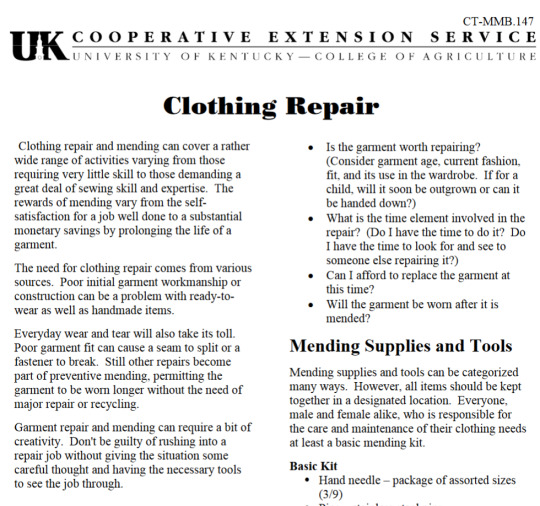
link to PDF
57K notes
·
View notes
Text
Industry trend|In order to eliminate fake Yangcheng Lake crabs, we have given each real crab an ID card.
In the cool autumn season, Yangcheng Lake hairy crabs have become an autumn delicacy in the hearts of countless diners with their delicious meat, rich nutrition and unique taste. However, as Yangcheng Lake hairy crabs have become famous, a counterfeit trend has quietly emerged in the market. Fake Yangcheng Lake hairy crabs have emerged in an endless stream, which not only harms the rights and interests of consumers, but also has a great impact on the brand image of Yangcheng Lake hairy crabs, a local specialty. In order to eliminate this phenomenon from the source, the "Zhencheng Crab" brand has taken an innovative measure-equipped each real Yangcheng Lake hairy crab with a unique "ID card".
This "ID card" is not a paper document in the traditional sense, but an intelligent NFC anti-counterfeiting label created using modern Internet of Things technology and blockchain technology. Compared with traditional barcode and QR code traceability methods, this chip-level traceability technology has a higher anti-counterfeiting threshold and reliability. Once the information is written into the chip, it cannot be tampered with or copied, which greatly improves the accuracy and security of traceability. After strict quality inspection, each Yangcheng Lake crab that is caught and brought ashore is given a unique identification code. This identification code not only records the crab's fishing date, origin, weight, crab shell color and other basic information, but also ensures that the information cannot be tampered with through blockchain technology, truly achieving full traceability from breeding to dining table.

When consumers buy Yangcheng Lake crabs, they only need to use the NFC function of their mobile phones to gently touch the crab buckle to quickly read the crab's traceability information. This transparent traceability mechanism allows consumers to intuitively distinguish the authenticity, greatly enhancing consumer confidence. At the same time, it also provides strong technical support for the brand building of Yangcheng Lake crabs, allowing real high-quality products to stand out and be free from counterfeit and shoddy products.
By equipping each real crab with an "ID card", the "Zhencheng Crab" brand has established a complete anti-counterfeiting system, providing a powerful weapon to combat counterfeit Yangcheng Lake crabs. Once counterfeit products are found on the market, relevant departments can quickly track the source of counterfeit products by comparing the anti-counterfeiting label information and crack down on them in accordance with the law. This not only protects the legitimate rights and interests of consumers, but also maintains the fair competition order of the Yangcheng Lake crab market and promotes the healthy development of the industry.
The successful use of NFC by "Zhencheng Crab" is a vivid practice of technology empowering agriculture. Through the application of IoT technologies such as RFID, traditional agriculture has been given new vitality. This innovation not only improves the quality and reputation of products, but also provides farmers with a wider sales channel. At the same time, it also helps to protect the sustainable development of the branded agricultural product industry, making consumers more assured and satisfied when purchasing.
This paper is from Ulink Media, Shenzhen, China, the organizer of IOTE EXPO (IoT Expo in China)
0 notes
Text
Unlock the Power of AI with High-Quality Image Classification Datasets

In the realm of artificial intelligence (AI) and machine learning (ML), the significance of a well-structured image classification dataset cannot be overstated. It forms the foundation for training AI models to accurately categorize and classify objects, scenes, or actions within an image. Whether it’s recognizing handwritten digits, identifying specific products in retail, or diagnosing medical conditions from X-rays, image classification is critical for countless applications. At GTS AI, we specialize in providing image classification services to ensure your AI models are trained with high-quality data for optimum performance.
What is Image Classification?
Image classification is a process in machine learning where an AI model learns to assign predefined labels or categories to an image based on its content. This process requires a vast dataset of labeled images, which the model uses to understand the features and characteristics that define each category. The more diverse and accurate the dataset, the better the AI model becomes at making accurate predictions.
For example, in an e-commerce setting, an image classification model can categorize product images into predefined classes such as "shoes," "electronics," "furniture," and "clothing." Similarly, in medical imaging, AI models can be trained to detect and classify abnormalities like tumors or lesions in X-rays or MRI scans.
The Importance of a High-Quality Image Classification Dataset
A robust and well-annotated image classification dataset is essential for training an accurate machine learning model. Here are some key reasons why a high-quality dataset matters:
Improved Model Accuracy: High-quality datasets with precise annotations help train models that make fewer mistakes and provide accurate classifications. The better the data, the higher the likelihood that the AI system will identify and categorize images correctly in real-world situations.
Faster Training Time: Well-labeled and structured datasets allow machine learning models to learn faster and more efficiently. With clear and consistent labels, models can process and understand data quicker, reducing the time required for training.
Scalability: As AI models evolve, they require more complex datasets to remain effective. A scalable image classification dataset ensures that the model continues to improve as more data becomes available, allowing it to handle increasingly complex tasks.
Versatility: Image classification datasets are adaptable across industries. Whether you’re working in healthcare, retail, agriculture, or security, the ability to provide accurate image classification enables AI systems to deliver effective solutions in a variety of fields.
How Image Classification Works
Image classification models rely on deep learning techniques such as convolutional neural networks (CNNs) to process images and extract useful features. Here’s how the process works:
Dataset Collection: The first step involves gathering a large dataset of images, each labeled with the correct class. For instance, in a dataset for classifying animals, each image would be labeled as "cat," "dog," "bird," etc.
Data Preprocessing: Images in the dataset are preprocessed to ensure consistency. This includes resizing images, normalizing pixel values, and applying data augmentation techniques like rotation, cropping, or flipping to increase diversity in the dataset.
Model Training: The annotated dataset is fed into a machine learning model, often a CNN, which learns to detect patterns and features within the images. During training, the model adjusts its internal parameters based on the labeled examples, improving its ability to classify new, unseen images.
Model Testing and Validation: After training, the model is tested on a separate set of data (the validation set) to evaluate its accuracy and generalization capabilities. The model’s performance is fine-tuned by comparing its predictions against the actual labels.
Real-World Application: Once the model achieves satisfactory accuracy, it is deployed for real-world image classification tasks, such as identifying objects in a surveillance video, diagnosing medical conditions, or recommending products on an e-commerce site.
Applications of Image Classification Across Industries
Image classification has far-reaching applications in numerous industries. Here are some of the key use cases:
Healthcare: AI-powered image classification is revolutionizing healthcare by helping doctors detect and diagnose diseases from medical images. For example, image classification models can identify tumors in X-rays, categorize different stages of cancer, or detect retinal diseases from eye scans.
Retail and E-commerce: Image classification enhances the customer experience by enabling AI systems to automatically categorize products, recommend similar items, and detect defects or counterfeit products. For instance, in e-commerce, a user can upload an image, and the system will classify and recommend related products.
Agriculture: In agriculture, AI models trained on image classification datasets help farmers monitor crop health, detect pests, and assess yield potential. Image classification can identify signs of plant diseases early, allowing farmers to take timely actions to prevent damage.
Security and Surveillance: Security systems use image classification to detect unusual behavior or identify objects in surveillance footage. AI can be trained to recognize faces, detect weapons, or flag suspicious activities in real time, improving safety and response times.
Autonomous Vehicles: Autonomous vehicles rely on image classification models to recognize and classify objects on the road, such as pedestrians, traffic signs, and other vehicles. This is crucial for making real-time decisions and ensuring safe navigation.
Why Choose GTS AI for Image Classification Services?
At GTS AI, we provide top-notch image classification services to help businesses train accurate and reliable AI models. Here’s why partnering with us ensures the success of your image classification projects:
Expert Annotators: Our team of experienced annotators meticulously labels images to ensure the highest accuracy and consistency. Whether you need simple object classification or complex multi-label datasets, we’ve got you covered.
Advanced Tools: We use cutting-edge tools and technologies to speed up the annotation process without compromising on quality. Our tools are designed to handle large-scale image datasets, ensuring efficiency and precision.
Custom Solutions: We tailor our services to meet the unique needs of your industry. Whether you need datasets for healthcare, retail, or any other sector, we provide flexible and customized solutions to match your project requirements.
Data Security: We prioritize data security and confidentiality, ensuring that your sensitive information is protected throughout the annotation process.
Conclusion
Image classification is a cornerstone of modern AI, enabling systems to understand and interpret visual data. A high-quality image classification dataset is key to building accurate, efficient, scalable AI models. At GTS AI, we specialize in providing comprehensive image classification services that ensure your AI models are trained with the best possible data. Whether you're working in healthcare, retail, agriculture, or security, our team is here to support your AI initiatives with precision and expertise.
Visit our Image Classification Services page to learn how we can help you enhance your AI models with high-quality data!
0 notes
Text
Boost Agricultural AI Training with Precise Image Labeling | Haivo AI
Haivo AI is a leading company specializing in agriculture image labeling and dataset creation. Our precise labeling services provide high-quality training data to enhance agricultural AI models. Accelerate your agricultural projects with Haivo AI's expert solutions.

0 notes
Text
New filtration material could remove long-lasting chemicals from water
New Post has been published on https://sunalei.org/news/new-filtration-material-could-remove-long-lasting-chemicals-from-water/
New filtration material could remove long-lasting chemicals from water
Water contamination by the chemicals used in today’s technology is a rapidly growing problem globally. A recent study by the U.S. Centers for Disease Control found that 98 percent of people tested had detectable levels of PFAS, a family of particularly long-lasting compounds also known as “forever chemicals,” in their bloodstream.
A new filtration material developed by researchers at MIT might provide a nature-based solution to this stubborn contamination issue. The material, based on natural silk and cellulose, can remove a wide variety of these persistent chemicals as well as heavy metals. And, its antimicrobial properties can help keep the filters from fouling.
The findings are described in the journal ACS Nano, in a paper by MIT postdoc Yilin Zhang, professor of civil and environmental engineering Benedetto Marelli, and four others from MIT.
PFAS chemicals are present in a wide range of products, including cosmetics, food packaging, water-resistant clothing, firefighting foams, and antistick coating for cookware. A recent study identified 57,000 sites contaminated by these chemicals in the U.S. alone. The U.S. Environmental Protection Agency has estimated that PFAS remediation will cost $1.5 billion per year, in order to meet new regulations that call for limiting the compound to less than 7 parts per trillion in drinking water.
Contamination by PFAS and similar compounds “is actually a very big deal, and current solutions may only partially resolve this problem very efficiently or economically,” Zhang says. “That’s why we came up with this protein and cellulose-based, fully natural solution,” he says.
“We came to the project by chance,” Marelli notes. The initial technology that made the filtration material possible was developed by his group for a completely unrelated purpose — as a way to make a labelling system to counter the spread of counterfeit seeds, which are often of inferior quality. His team devised a way of processing silk proteins into uniform nanoscale crystals, or “nanofibrils,” through an environmentally benign, water-based drop-casting method at room temperature.
Zhang suggested that their new nanofibrillar material might be effective at filtering contaminants, but initial attempts with the silk nanofibrils alone didn’t work. The team decided to try adding another material: cellulose, which is abundantly available and can be obtained from agricultural wood pulp waste. The researchers used a self-assembly method in which the silk fibroin protein is suspended in water and then templated into nanofibrils by inserting “seeds” of cellulose nanocrystals. This causes the previously disordered silk molecules to line up together along the seeds, forming the basis of a hybrid material with distinct new properties.
By integrating cellulose into the silk-based fibrils that could be formed into a thin membrane, and then tuning the electrical charge of the cellulose, the researchers produced a material that was highly effective at removing contaminants in lab tests.
By integrating cellulose into the silk-based fibrils that could be formed into a thin membrane, and then tuning the electrical charge of the cellulose, the researchers produced a material that was highly effective at removing contaminants in lab tests. Pictured is an example of the filter.
Image: Courtesy of the researchers
Previous item Next item
The electrical charge of the cellulose, they found, also gave it strong antimicrobial properties. This is a significant advantage, since one of the primary causes of failure in filtration membranes is fouling by bacteria and fungi. The antimicrobial properties of this material should greatly reduce that fouling issue, the researchers say.
“These materials can really compete with the current standard materials in water filtration when it comes to extracting metal ions and these emerging contaminants, and they can also outperform some of them currently,” Marelli says. In lab tests, the materials were able to extract orders of magnitude more of the contaminants from water than the currently used standard materials, activated carbon or granular activated carbon.
While the new work serves as a proof of principle, Marelli says, the team plans to continue working on improving the material, especially in terms of durability and availability of source materials. While the silk proteins used can be available as a byproduct of the silk textile industry, if this material were to be scaled up to address the global needs for water filtration, the supply might be insufficient. Also, alternative protein materials may turn out to perform the same function at lower cost.
Initially, the material would likely be used as a point-of-use filter, something that could be attached to a kitchen faucet, Zhang says. Eventually, it could be scaled up to provide filtration for municipal water supplies, but only after testing demonstrates that this would not pose any risk of introducing any contamination into the water supply. But one big advantage of the material, he says, is that both the silk and the cellulose constituents are considered food-grade substances, so any contamination is unlikely.
“Most of the normal materials available today are focusing on one class of contaminants or solving single problems,” Zhang says. “I think we are among the first to address all of these simultaneously.”
“What I love about this approach is that it is using only naturally grown materials like silk and cellulose to fight pollution,” says Hannes Schniepp, professor of applied science at the College of William and Mary, who was not associated with this work. “In competing approaches, synthetic materials are used — which usually require only more chemistry to fight some of the adverse outcomes that chemistry has produced. [This work] breaks this cycle! … If this can be mass-produced in an economically viable way, this could really have a major impact.”
The research team included MIT postdocs Hui Sun and Meng Li, graduate student Maxwell Kalinowski, and recent graduate Yunteng Cao PhD ’22, now a postdoc at Yale University. The work was supported by the U.S. Office of Naval Research, the U.S. National Science Foundation, and the Singapore-MIT Alliance for Research and Technology.
0 notes